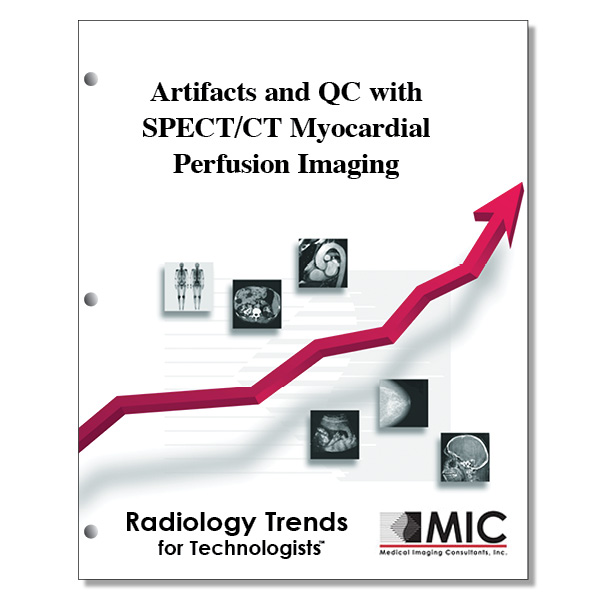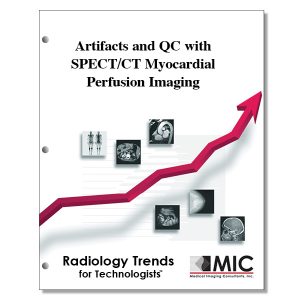

Artifacts and QC with SPECT/CT Myocardial Perfusion Imaging
An overview of SPECT/CT myocardial perfusion imaging including discussions of radiotracers, patient preparation, stress induction protocols, image acquisition and artifact avoidance.
Course ID: Q00339 Category: Radiology Trends for Technologists Modalities: CT, Nuclear Cardiology, Nuclear Medicine3.0 |
Satisfaction Guarantee |
$34.00
- Targeted CE
- Outline
- Objectives
Targeted CE per ARRT’s Discipline, Category, and Subcategory classification for enrollments starting after June 11, 2024:
[Note: Discipline-specific Targeted CE credits may be less than the total Category A credits approved for this course.]
Nuclear Medicine Technology: 3.00
Procedures: 3.00
Cardiac Procedures: 3.00
Registered Radiologist Assistant: 2.00
Procedures: 2.00
Thoracic Section: 2.00
Outline
- Introduction
- Radiotracers
- Patient Preparation
- Stress Induction Protocols
- Image Acquisition Protocol
- Image Display
- Image Interpretation and Reporting
- Attenuation Correction and Artifacts
- Artifacts of Soft Tissue Attenuation
- Artifacts of Subdiaphragmatic Radiotracer Activity
- Artifacts of Patient Motion
- Artifacts of Misregistration
- Artifacts of Left Bundle Branch Block
- Effects of Normal Apical Thinning
- Conclusions
Objectives
Upon completion of this course, students will:
- understand what role myocardial perfusion imaging (MPI) plays in assessing CAD
- be familiar with imaging technology used to perform CT attenuation
- identify which radiotracers are commonly used for MPI
- understand the pharmacological properties for Thallous chloride
- be familiar with distribution of Tc-labeled radiotracers in the myocardium
- be familiar with other advantages of Tc-labeled radiotracers in the human body
- be familiar with the first pass extraction fractions of the MPI radiotracers
- be familiar with proper patient preparation for MPI
- understand which drugs can interfere with diagnostic MPI examinations
- be familiar with the disadvantages of patients taking Viagra prior to MPI
- be familiar with the contraindications for performing MPI on acute MI patients
- understand the advantages of “stress only” MPI
- be able to calculate a patient’s maximum predicted heart rate for MPI
- identify the preferred pharmacological stress-induction agent for MPI
- understand the biological characteristics for adenosine
- be familiar with drugs that can counter react dipryridamole and regadenoson
- be familiar with using a nylon strap around the patient’s abdomen
- be familiar with the number of ECG-gated frames for SPECT MPI
- be familiar with the energy window used to optimize SPECT MPI
- identify which collimator is preferred for SPECT MPI
- identify what matrix should be used for SPECT MPI
- know why to inspect the raw data sets for SPECT/CT MPI prior to a physician’s interpretation of the images
- identify what malignancies may be detected on a SPECT/CT MPI
- be familiar with a two dimensional display of radiotracer activity in the left ventricle
- identify the areas of the myocardium displayed on a polar map
- be familiar with organization that recommends QC protocol for SPECT imaging
- identify the artifacts that will present with bad detector uniformity
- understand artifacts when anatomy extends beyond the CT FOV
- identify the traditional SPECT MPI cardiac planes
- identify how to differentiate SPECT attenuation artifact vs. myocardial infarction
- be familiar with a frequently used SPECT/CT MPI polar map
- understand the segmental scoring map created from SPECT/CT MPI
- be familiar with summed stress scores generated from SPECT/CT MPI polar maps
- identify the factors that create attenuation artifacts on SPECT/CT MPI
- be familiar with common sites for MPI patient-based attenuation artifacts
- be familiar with MPI patient positioning used to reduce attenuation artifacts
- identify the source of subdiaphragmatic radiotracer activity on SPECT/CT MPI
- be familiar with the methods for detecting attenuation artifacts on SPECT/CT MPI
- be familiar with SPECT/CT MPI artifacts created by left bundle branch block
- be familiar with the cardiac planes that best demonstrate myocardial apical thinning
